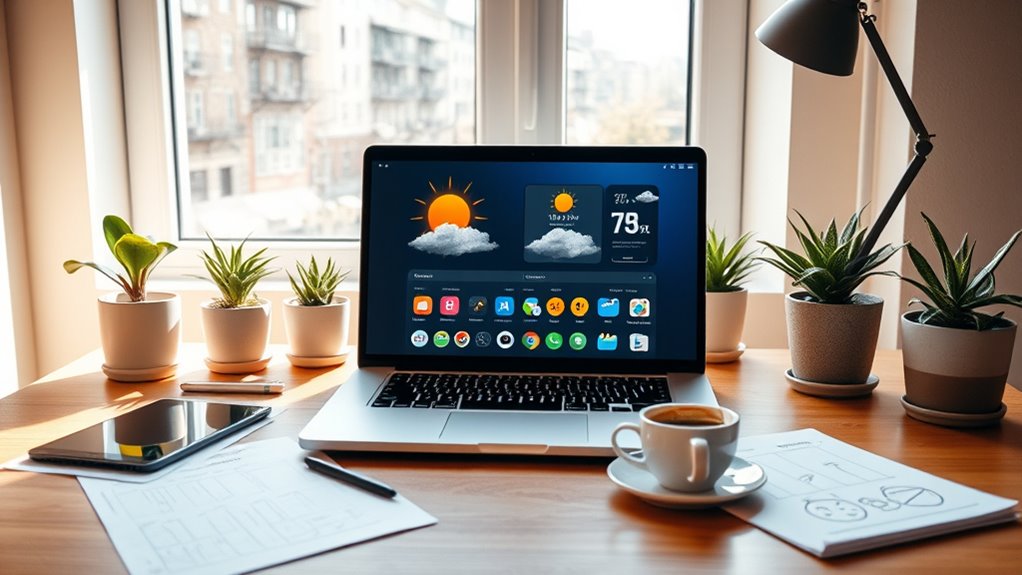To build a weather app with vibe coding, you’ll start by setting up a project and selecting a reliable weather API for accurate data. Design a user-friendly interface with intuitive navigation and interactive elements. Key features like real-time updates, forecasts, and notifications will enhance user engagement. Integrate AI for personalized forecasts and utilize effective testing methods. If you want to uncover more tips and strategies for your app’s success, keep exploring the details ahead!
Key Takeaways
- Start by setting up your development environment, ensuring you have a code editor and version control like Git for efficient coding.
- Select a reliable weather API for accurate data, focusing on options like Meteomatics that support RESTful calls and JSON.
- Utilize vibe coding techniques to streamline the coding process, allowing for faster generation of weather app functionalities.
- Design a user-friendly interface that prioritizes clarity, featuring dynamic elements like interactive maps and personalized notifications.
- Implement CI/CD practices for smooth deployment and regular updates, ensuring your app stays relevant and user-friendly over time.
Project Setup

To kick off your weather app project, start by outlining its core features and objectives. Identify what users expect, focusing on their needs for accurate, timely weather information. Additionally, consider integrating user-friendly design elements to enhance the overall user experience. Furthermore, incorporating AI-driven personal assistants could provide users with personalized weather updates based on their preferences.
Next, research existing weather apps to pinpoint gaps and opportunities for improvement. This competitor analysis helps you create a unique offering.
Decide which platforms you’ll develop for, whether web, mobile, or both, ensuring you reach your target audience effectively.
Allocate your budget wisely, planning resources for development, testing, and ongoing maintenance.
Finally, set up your development environment with a suitable code editor like Visual Studio Code, a version control system like Git, and a local server for testing. This solid foundation prepares you for the upcoming design and development phases.
Choosing a Weather API

After setting up your project, the next step involves selecting a reliable weather API that meets your app’s needs.
Consider factors like data variety and accuracy. For instance, Meteomatics offers over 1800 weather parameters and has superior accuracy, especially in complex terrains. Additionally, many of the top APIs, such as Tomorrow.io’s Weather API, provide access to a wide range of weather data, enhancing the capabilities of your application.
When selecting a weather API, prioritize data variety and accuracy, like Meteomatics with its extensive 1800+ parameters.
If you need geographical coverage, look for APIs with high-resolution models, such as those provided for the U.S. and Europe.
Evaluate pricing models too; AerisWeather starts at $23/month with a free trial, while Accuweather offers limited free access.
Don’t forget integration formats; most APIs support RESTful calls with JSON.
Finally, verify the API has thorough documentation and support to make your integration process smoother and more efficient.
Choose wisely to enhance your app’s functionality!
Designing the User Interface

When designing the user interface for your weather app, it’s essential to prioritize clarity and simplicity to guarantee users can quickly grasp the information presented.
Start by using an intuitive layout that emphasizes key weather data like temperature and forecasts. Incorporate colorful, recognizable icons that enhance usability and adapt well to different lighting conditions. Effective design balances visual appeal and usability to retain users while ensuring they have quick access to essential information. Additionally, consider incorporating predictive analytics to enhance user experience by anticipating user needs based on their location and preferences.
Keep the design consistent throughout the app to improve user experience. Make certain your app is responsive, functioning seamlessly across various devices and screen sizes.
Avoid clutter—focus on clean visuals that highlight essential information. Finally, consider accessibility features to cater to users with different abilities, making your app inclusive and user-friendly.
This thoughtful approach will enhance overall engagement with your app.
Key Features for a Weather App

Key features of a weather app greatly enhance user experience and functionality, ensuring you have the most relevant information at your fingertips.
Start with real-time weather displays, showing temperature, humidity, and conditions like rain or sunshine. Incorporate forecasting options for hourly, daily, and weekly insights to help you plan ahead. Including solar energy solutions can be beneficial for users interested in sustainable living and how weather affects their energy consumption. Additionally, incorporating maintenance responsibilities related to weather impacts can help users better prepare for seasonal changes. Awareness of store hours can also assist users in planning shopping trips around weather conditions. Indexed annuities can also be considered for users looking to protect their finances against inflation as they plan for future expenses.
Real-time weather displays and comprehensive forecasting empower you to plan your day with confidence.
Enable location detection for automatic updates and allow tracking of multiple locations. Add interactive radar maps for visualizing weather patterns and offer features like pollen counts and air quality data. Seven out of ten Americans use weather apps for daily planning, making these features even more essential.
Don’t forget push notifications for severe weather alerts. Customization options for units and themes enhance personalization, while bookmarks for frequently accessed locations streamline your experience. These features combine to create an all-encompassing, user-friendly weather app.
Using AI for Speed and Convenience

As you navigate the ever-changing landscape of weather forecasting, using AI can greatly enhance both speed and convenience. AI technologies analyze vast datasets, recognizing complex patterns that improve forecast accuracy considerably. This rapid processing generates forecasts tens of times faster than traditional methods, making real-time updates possible. Systems like Aardvark Weather demonstrate how AI can streamline forecasting, offering hyper-local weather data at your fingertips. Additionally, integrating AI-driven APIs into your weather app guarantees users receive timely, personalized forecasts based on their location. Aardvark is capable of operating on a desktop computer with minimal data, which further emphasizes its accessibility. While challenges like data biases exist, the transformative potential of AI in weather prediction can’t be overstated. By leveraging AI, you’ll create a more efficient, user-friendly experience that keeps your app competitive in the market. Moreover, vibe coding can empower developers to quickly generate code snippets that enhance app functionality.
Testing and Deployment

To guarantee your weather app functions seamlessly and meets user expectations, thorough testing and deployment strategies are essential.
Start with unit testing to ascertain individual components work correctly, followed by integration testing to verify their interactions. Conduct functionality, performance, and security testing to confirm the app performs well under various conditions and is secure against vulnerabilities. Additionally, ensure your app is equipped with essential features like basic weather forecasts, as this can significantly enhance user satisfaction.
When it comes to deployment, consider platforms like web servers, mobile app stores, or even IoT devices for broader reach.
Utilize CI/CD tools to automate the process and version control systems like Git to manage your code. After deployment, focus on post-deployment monitoring, gathering user feedback, and planning updates to continuously enhance your app’s performance and user experience.
API Integration

Integrating APIs is an important step in building a functional weather app, and it allows you to access a wealth of real-time weather data.
Start by selecting a reliable weather API like OpenWeatherMap or Visual Crossing. These APIs typically provide data in formats like JSON, making integration straightforward. You’ll make API calls using JavaScript methods like fetch() to retrieve data. Once you receive the data, parse it to extract key information such as temperature and humidity.
Selecting a reliable weather API, such as OpenWeatherMap or Visual Crossing, simplifies integration with accessible JSON data.
Dynamic UI updates are vital for displaying this information effectively. Don’t forget to follow the API documentation for correct integration and implement error handling to manage issues like invalid requests. Finally, make sure you secure API access with proper keys and configurations to build a weather app.
Enhancing User Experience

How can you make your weather app stand out in a crowded market? Start by simplifying navigation with a clear layout and intuitive design.
Enable customizable searches so users can effortlessly find weather conditions for any location. Incorporate real-time updates to boost reliability and credibility. Engage users with feedback mechanisms to improve your app continuously. Additionally, invest in reliable weather data sources to provide accurate forecasts that users can trust.
Visually, use interactive maps, weather-themed icons, and dynamic backgrounds that reflect current conditions.
Personalization is key—allow users to customize widgets, notifications, and measurement units. Consider gamification and social sharing features to enhance interaction and visibility.
Regular updates guarantee your app remains fresh and relevant, keeping users coming back for more. By focusing on these aspects, you’ll greatly enhance user experience.
Frequently Asked Questions
What Programming Languages Are Best for Building a Weather App?
When you’re building a weather app, consider using Swift for iOS or Java for Android development.
If you’re focusing on web apps, JavaScript with HTML and CSS is your best bet.
Python’s great for data processing and integrating various weather data sources.
Don’t overlook PHP for backend services, though it’s less common.
For cross-platform apps, frameworks like React Native can help you use JavaScript effectively across devices.
Choose the language that fits your goals!
How Do I Handle API Rate Limits in My App?
To handle API rate limits in your app, start by setting clear limits for requests within defined time windows.
Use methods like the Fixed Window or Token Bucket algorithms to manage usage effectively.
Monitor client activity regularly and communicate limits to avoid confusion.
When clients exceed limits, provide clear error messages and options to retry.
Implement temporary blocks for repeat offenders and consider adjusting limits based on feedback to improve user experience.
Can I Integrate Multiple Weather APIS Simultaneously?
Imagine a weather symphony, where different instruments create a richer sound. Yes, you can integrate multiple weather APIs simultaneously!
By doing so, you guarantee redundancy and enhance accuracy. Each API brings unique data, giving you a thorough view of conditions.
Just remember to manage API keys and handle errors gracefully. With a well-structured approach, your app can become a powerhouse of information, providing users with real-time updates and tailored forecasts.
What Tools Can I Use for Debugging My Weather App?
To debug your weather app effectively, you can use several tools.
Start with Postman to test your API requests and responses, ensuring data retrieval works smoothly.
Leverage browser developer tools like Chrome DevTools for inspecting network activity and console logs.
In Visual Studio Code, utilize debugging extensions to streamline the process.
Collaborate with tools like JS Bin for live debugging sessions, helping you identify and fix issues quickly and efficiently.
How Do I Ensure My App Is Secure From Vulnerabilities?
To guarantee your app is secure from vulnerabilities, start by implementing robust authentication and authorization methods.
Encrypt data both in transit and at rest to protect it from breaches.
Regularly conduct vulnerability scans and penetration tests to identify weaknesses.
Follow secure coding guidelines and perform code reviews to catch issues early.
Educate users on security practices and confirm third-party libraries are regularly verified for security compliance.
Staying proactive is key to maintaining your app’s security.
Conclusion
So, there you have it! You’ve built a weather app that not only predicts rain but also prepares you for the emotional storm of forgetting your umbrella. Who needs meteorologists when you’ve got your coding skills? Remember, if your app fails to load, just blame the weather—everyone else does! Now go forth, release your creation into the wild, and let it rain compliments (or critiques). After all, every forecast needs a little unpredictability, right?









